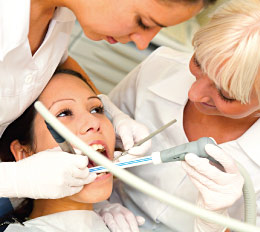Dental Cleanings Using Ultrasonic Scalers
Ultrasonic or hand scalers — which are better?
Dear Doctor,
Sometimes when I go for a dental cleaning, the hygienist uses an ultrasonic scaler. Please provide information about these devices and what makes them different from traditional scalers?

Dear Jill,
Your question is not uncommon. As you pointed out, dental hygiene has evolved and so have the goals for cleaning your teeth through periodontal (“perio” – around; “odont” – tooth) therapy to prevent and/or treat gum disease. During the 1960s, it was becoming clear that dental bacterial plaque or biofilm was the primary agent causing periodontal (gum) disease. Cleaning to remove hard deposits accumulated on teeth is generally known as scaling. Although studies up to that time showed that (manual) hand scaling instruments produced significantly smoother root surfaces compared to ultrasonic or power scaling, there was no real evidence that it reduced inflammation, a primary goal of periodontal therapy.
The newer terms “non-surgical periodontal therapy” and “periodontal debridement” more accurately reflect the newer treatment goals of dental hygiene with a primary emphasis on disrupting bacterial plaque biofilms while minimizing damaging the root structure during calculus removal (Calculus or tartar — calcified bacterial products that collect and attach to the tooth and root surfaces). In other words, these new treatment options enable your hygienist to remove the tartar and biofilms from your teeth with minimal-to-no damage to tooth roots — a critical step to arrest periodontal infection and maintain good oral health.
The use of power scalers began in the late 1950s when it was apparent that ultrasound could effectively remove deposits from teeth. From their initial use in removal of supra-gingival (“supra” – above; “gingival” – gum level) to their current application for the removal of supra and sub-gingival (“sub” – beneath) calculus, plaque biofilms, and bacterial byproducts, research has shown power scaling to be at least as effective as manual, hand-held instruments and in some cases superior.
Most periodontal experts agree that the best results for non-surgical therapy are achieved by combining the use of power ultrasonic scalers and hand instruments.
Power Scalers And How They Work
The main action of power scalers is mechanical; the high vibrational energy crushes and removes calculus. Other actions include: creating shockwaves that disrupt bacterial cells, or using turbulence to disrupt biofims, and irrigation — the therapeutic washing and flushing of the periodontal pocket and root surface with cooling water. Both power and hand scaling techniques require an experienced clinician with good tactile sensitivity (sense of touch) to remove deposits effectively and to promote healing.
Pros And Cons Of Power Driven Scalers
Research shows power scaling instruments have advantages:
- They are as effective as manual instruments for calculus removal in shallow gum pockets and significantly more effective in pockets greater than 4mm.
- They are very effective in disrupting biofilm from root surfaces and from within periodontal pockets making them especially helpful when patients require frequent maintenance (cleanings).
- Specially designed tips can penetrate deeper into periodontal pockets than manual instruments and are more effective at cleaning difficult nooks and crannies like furcations, (areas where roots join each other in multi-rooted teeth).
- When used correctly they are kinder to tooth structure, which is especially important with repeated cleanings (when used correctly).
- Coolant sprays provide irrigation (flushing of the area), which improves healing by removing bacteria and their bi-products as well as the hygienist's ability to see when scaling.
- They require less time than manual instruments for the same job.
- Their smaller tips cause less tissue distention and require very little pressure — thus making it more comfortable for you, the patient!
Cautions Regarding Power Scalers
- Aerosol production (the formation of contaminated “mist”) requires protective equipment; not a problem for experienced dental professionals.
- Power scalers may affect certain cardiac (heart) pacemakers! Although most modern pacemakers are shielded, tell your dentist and/or hygienist if you have one.
- Ultrasonic power scalers are not recommended for individuals with hypersensitive teeth, which may include primary teeth or newly erupted teeth. Please tell your dentist or hygienist if your teeth are sensitive to temperature change.
- Ultrasonic scalers are also not recommended for areas of demineralization (early mineral loss leading to decay), porcelain or composite restorations and titanium implants — unless specially designed tips are used which won't scratch them.
Most periodontal experts today agree that the best results for non-surgical periodontal therapy are achieved by a blended approach; the combined use of power ultrasonic scalers and hand instruments. Rapidly changing technology has revolutionized periodontal therapy with integration of power scaling techniques resulting in improved clinical outcomes, patient comfort, and reduced time and physical demands on clinicians.



